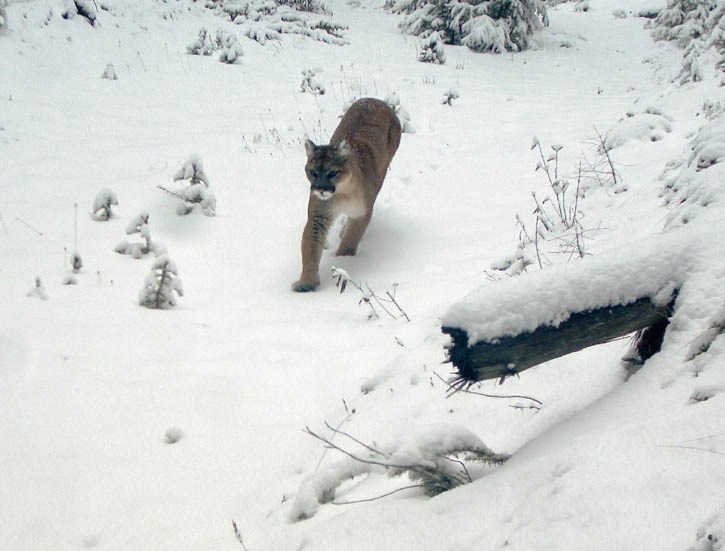They are ghosts of the forest. Silent, like a fog, moving on padded paw through dense underbrush, secluded trails and mountainous slopes.
They are rarely seen, yet haunt even the hardiest of mountain dwellers. They are the primary carnivores of the mountains, the fourth-largest cat in the world, and their numbers are strengthening across Alberta.
From 2001 to 2013, the estimated number of cougars province-wide has grown from 650 to 2,000, according to District Fish and Wildlife biologist Jay Honeyman, while human-cougar conflicts in the Bow Valley have reached 300 over that 12-year period.
That number doesn’t include sightings in the wild. Across the province, cougar conflicts have seen a steady rise from less than 200 incidents to nearly 900. By no coincidence, cougar deaths have reached 240, as they fall victim to road, rail and guns.
“There’s lots of expansion in the north and the east. Cougars are moving into more developed areas,” Honeyman said. “Cougars are becoming more used to people. We’re seeing activity in the daytime and sometimes people see them on a trail in broad daylight. We are seeing a level of habituation provincially, cougars living in developed areas, and that is creating more conflicts. Most people are OK having them around … but not in their backyard.”
In the Bow Valley, 2013 was a peak year for human-cougar conflicts, topping out at 61. The conflicts ranged from backyard sightings (ranked low conflict) to attacks on dogs (high conflict).
Reported conflict numbers have increased every year since 2006, however, wildlife officials point out that’s also the year Bow Valley Wildsmart was introduced, as was the Kananaskis Wildlife Reporting system.
“We may not have more cougar conflicts, but they are getting reported more often,” Honeyman said.
Of the reported sightings, Canmore is the hot spot. Seventy-five per cent of reported human-cougar conflicts in the Bow Valley have fallen within the Town of Canmore boundaries, dwarfing the number of conflicts on provincial trails (13 per cent) and in the MD of Bighorn (12 per cent).
Dogs were involved in the most high-level cougar conflicts in developed areas. Twenty-four canines were involved in cougar encounters between 2001 and 2013, with the majority of those conflicts coming in December and March. Five deer, three rabbits, two humans, two horses, two cats, one bird and one bighorn sheep have also been reported attacked by cougars in developed areas. Officers see a spike in July, with December and January being the second-most active months for incidents.
“This is just what’s reported to us. It’s not the full picture. We’re not sure how much is actually happening out there,” Honeyman said.
Of 24 cougars killed in the Bow Valley between 2001 and 2013, roads and railways are the biggest cause of mortality, accounting for 63 per cent of all cougar deaths. Public safety officers were responsible for 21 per cent of cougar deaths, while another 12 per cent died due to unknown causes. Only one cougar has been killed by a hunter in the Bow Valley during that time. Overall, 2011 was the worst year for cougar deaths, with two killed on the Trans-Canada Highway, two killed on the railway and two killed by public safety.
Within Canmore, many sightings occur at the Canmore Nordic Centre, but in terms of conflict, neighbourhoods adjacent to wildlife corridors such as Rundleview, Silvertip and Peaks of Grassi see the highest number of incidents. In neighbourhoods where residents attempt to attract deer with saltlicks, or use birdfeeders, cougars are also attracted.
District Conservation Officer Glenn Naylor said cougars are active in the Bow Valley year round. Even with the number of reported conflicts on the rise, there are many more instances of people walking within metres of a cougar and not realizing it, Naylor said. He cites a group of five cougars – a mother and four large cubs – who were seen around the Bow Valley often on wildlife cameras, but never reported.
“I’ve seen three in my 36 years as a conservation officer in the wild – two were glances out of the corner of my eye and one was crossing a road,” said Naylor. “They make their living by surprise because they don’t want to get hurt.”
Naylor said the rules for avoiding an encounter are straightforward. Keeping dogs on leash minimizes encounters, as does travelling in groups and making noise on the trails. Bear spray is effective on cougars, and he recommends carrying a large stick. If you see a cougar, don’t take your eyes off it, don’t run and don’t crouch.
“Convince the cat you’re not prey, but a potential danger. If you’re attacked, use bear spray and always fight back.”
Children are also more susceptible for attacks.
A young girl attacked by a cougar in Kananaskis Country in 2011 likely survived the encounter because she was in sight, and walking directly with her group.
“Keep small children close to the group and in plain sight. If that girl who was attacked at Boundary Lake had been walking behind her family, it would have been 100 per cent a fatality,” Naylor said.
Cougar conflicts aren’t going away, Naylor said. Even after years of education and outreach programs, every year there are still problems as cougars enter developed areas. But those problems can be reduced by taking precautions.
“Alberta Parks and Fish and Wildlife are here to minimize conflict. We cannot eliminate it. We would have to get rid of all the cougars or all the people,” Naylor said. “We’re here to make sure they stay on the landscape. When a conflict occurs, we have to do things we don’t want to do. Without everyone doing their part, we can’t do much.”




